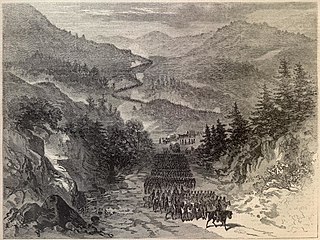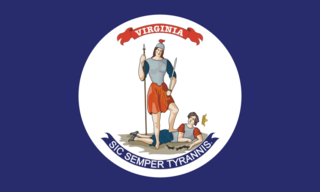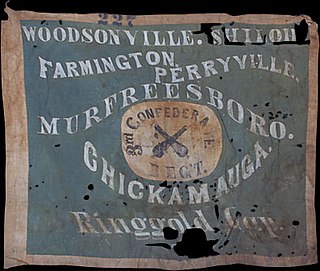
Joseph "Fighting Joe" Wheeler was an American military commander and politician. He is known for having served both as a cavalry general in the Confederate States Army in the 1860s during the American Civil War, and then as a general in the United States Army during both the Spanish–American War and Philippine–American War near the turn of the twentieth century. For much of the Civil War he served as the senior cavalry general in the Army of Tennessee and fought in most of its battles in the Western Theater.

The Battle of Day's Gap, fought on April 30, 1863, was the first in a series of American Civil War skirmishes in Cullman County, Alabama, that lasted until May 2, known as Streight's Raid. Commanding the Union forces was Col. Abel Streight; Brig. Gen. Nathan Bedford Forrest led the Confederate forces.

The Battle of Front Royal, also known as Guard Hill or Cedarville, was fought May 23, 1862, in Warren County, Virginia, as part of Confederate Army Maj. Gen. Thomas J. "Stonewall" Jackson's Campaign through the Shenandoah Valley during the American Civil War. Front Royal demonstrated Jackson's use of Valley topography and mobility to unite his own forces while dividing those of his enemies. At a minimal cost, he forced the withdrawal of a large Union army by striking at its flank and threatening its rear. This caused President Abe Lincoln to react by sending General Irvin McDowell's forces that were intended for General George B. McClellan's advance on Richmond, and caused it to come to a halt.

Gustav Tafel was a German-born colonel in the Union Army during the American Civil War, and the mayor of Cincinnati, Ohio, from 1897 to 1900.

The 1st Ohio Infantry Regiment was an infantry regiment in the Union Army during the American Civil War. It served in the Western Theater in a number of campaigns and battles.
The 2nd Maryland Infantry was an American military regiment in the Union Army during the American Civil War. It should not be confused with the 2nd Maryland Infantry, CSA, which was composed of Maryland volunteers who fought for the Confederacy during the war. The regiment fought at numerous battles during the course of the war, and lost 5 officers and 84 men killed and wounded, plus 3 officers and 134 men died of disease, for a total of 226 casualties.
The Battle of Rowlett's Station was a land battle in the American Civil War, fought at the railroad whistle-stop of Rowlett's in Hart County, Kentucky, on December 17, 1861. The outcome was inconclusive, although the Union Army continued to hold its objective, a railroad bridge across the Green River.

Philip Dale Roddey was a brigadier general in the army of the Confederate States of America during the American Civil War.
Galvanized Yankees was a term from the American Civil War denoting former Confederate prisoners of war who swore allegiance to the United States and joined the Union Army. Approximately 5,600 former Confederate soldiers enlisted in the "United States Volunteers", organized into six regiments of infantry between January 1864 and November 1866. Of those, more than 250 had begun their service as Union soldiers, were captured in battle, then enlisted in prison to join a regiment of the Confederate States Army. They surrendered to Union forces in December 1864 and were held by the United States as deserters, but were saved from prosecution by being enlisted in the 5th and 6th U.S. Volunteers. An additional 800 former Confederates served in volunteer regiments raised by the states, forming ten companies. Four of those companies saw combat in the Western Theater against the Confederate Army, two served on the western frontier, and one became an independent company of U.S. Volunteers, serving in Minnesota.

Alfred Gibbs was a career officer in the United States Army who served as a brigadier general in the Union Army during the American Civil War.
The 12th Missouri Infantry Regiment was an infantry regiment that served in the Union Army during the American Civil War. The regiment was organized by Colonel Peter J. Osterhaus, a veteran of the respected 2nd Missouri Volunteer Infantry. The majority of the soldiers in the 12th were ethnic Germans. This intermixed German-American unit also had a large portion of its ranks filled by volunteers from Illinois.
32nd Regiment Indiana Volunteer Infantry was a Union Army infantry regiment during the American Civil War. It was also known as Indiana's "1st German" regiment because its members were mainly of German descent. Organized at Indianapolis, the regiment's first recruits mustered into service on August 24, 1861. From 1861 to 1865, the 32nd Indiana was attached to the first Army of the Ohio and the Army of the Cumberland, where it served in the Western Theater.

The September 7–9, 1863 fall of the Cumberland Gap was a victory for Union forces under the command of Ambrose Burnside during his campaign for Knoxville. The bloodless engagement cost the Confederates 2,300 men and control of the Cumberland Gap.
The 7th Ohio Cavalry Regiment was a regiment of Union cavalry raised in southern Ohio for service during the American Civil War. Nicknamed the "River Regiment" as its men came from nine counties along the Ohio River, it served in the Western Theater in several major campaigns of the Army of the Ohio.
The 5th Ohio Cavalry Regiment was a regiment of Union cavalry raised in seven counties in southwestern Ohio for service during the American Civil War. It primarily served in the Western Theater in several major campaigns of the Army of the Tennessee.

The 36th Virginia Volunteer Infantry Regiment was an infantry regiment mostly raised in the Kanawha Valley for service in the Confederate States Army during the American Civil War. It fought mostly in western Virginia, Tennessee, and Kentucky.

The 18th Arkansas Infantry (Marmaduke's) (1861–1865) was a Confederate Army infantry regiment during the American Civil War. The unit was also briefly identified as the 1st Arkansas Infantry Battalion. The unit was most often referred to as the 3rd Confederate Infantry Regiment. The designation "Confederate Infantry Regiment" was intended to convey the difference between Provisional Confederate Army units and Regular Confederate Army Units, with Provisional units being those regiments who received a state designation such as "XX Arkansas Infantry Regiment". In practice, the designation was most often utilized when Regiments were assembled utilizing companies from more than one confederate state. The "3rd Confederate Infantry Regiment" is occasionally misidentified as the 3rd Arkansas Infantry Regiment commanded by Colonel Van H. Manning.

Also known as Law’s Brigade, the Alabama Brigade was a military formation of the Confederate States Army during the American Civil War. It was created in 1863 and participated in major combat operations such as the Battle of Gettysburg, the Battle of Chickamauga, the Battle of the Wilderness and the Richmond-Petersburg Campaign. It was considered one of the great fighting brigades of the Army of Northern Virginia.

The 3rd Texas Cavalry Regiment or South Kansas-Texas Mounted Volunteers was a unit of mounted volunteers that fought in the Confederate States Army during the American Civil War. The regiment fought at Wilson's Creek and Chustenahlah in 1861, Pea Ridge, Corinth siege, Iuka, Second Corinth, and the Holly Springs Raid in 1862, Thompson's Station in 1863, and in the Atlanta campaign and at Nashville in 1864. The regiment surrendered to Federal forces in May 1865 and its remaining 207 men were paroled.













